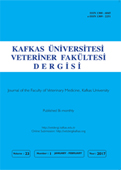
This journal is licensed under a Creative Commons Attribution-NonCommercial 4.0 International License
Kafkas Üniversitesi Veteriner Fakültesi Dergisi
2018 , Vol 24 , Issue 1
Using of Pelleted and Extruded Foods in Dog Feeding
1Selçuk University, Faculty of Veterinary Medicine, Department of Animal Nutrition and Nutritional Diseases, TR-42100 Konya - TURKEY2Selçuk University, Faculty of Veterinary Medicine, Department of Animal Breeding, TR-42100 Konya -TURKEY
3Çamlıca Mah. 133. Cad. 18/23 TR-06200 Yenimahalle, Ankara - TÜRKİYE DOI : 10.9775/kvfd.2017.18529 This study was carried out to determine the effects of pellet and extruded foods on gelatinization, digestibility and faecal quality of dogs. In study 30 adult male dogs of mixed breed, weighing 15-30 kg, neutered and around 1-3 of age were used. The two tested dog-food formulations had the same composition, but one was produced in pellet form, while the other was extruded in a private factory. Feeding experiments were conducted at the Dog Unit of the Veterinary Faculty in Selçuk University. Pelleted and extruded food contained 4.87% and 17.81% gelatinized starch, respectively (P<0.001). Tested dogs preferred extruded food at a rate of 0.66. The digestibility, faecal score, and cost of pelleted, extruded, imported, and domestic dog food were compared. The most common commercial brands were selected for the latter two categories. Based on faecal samples, the dry matter digestibility of the four dog-food types was 81.2%, 84.2%, 83.7%, 83.5% (P<0.05) respectively. The faecal score was 3.48 for dogs that consumed pelleted food and 3.68-3.91 for dogs fed the other three extruded foods. Cost calculations revealed that extruded food is five times more economical than imported food. Keywords : Extruded, Dog food, Digestibility, Pellet, Preference










